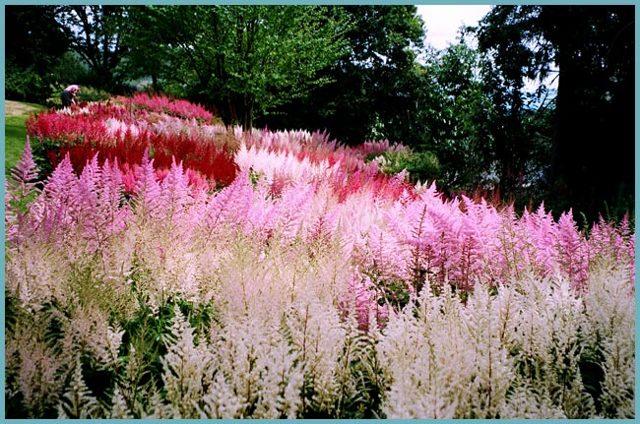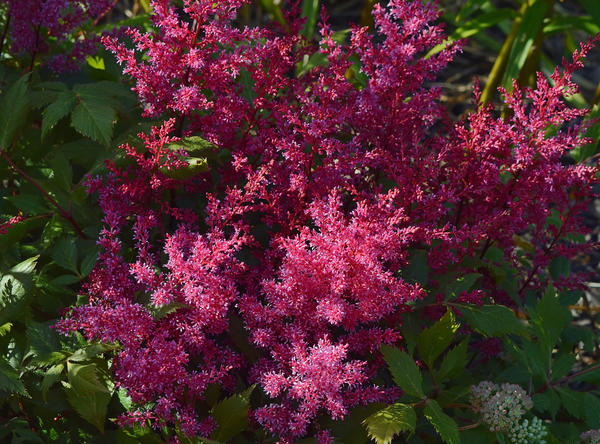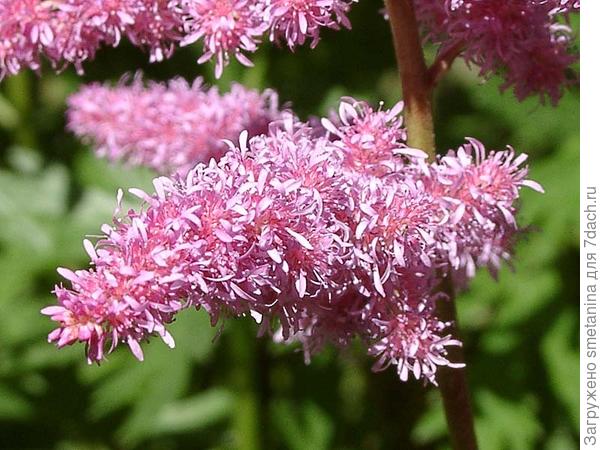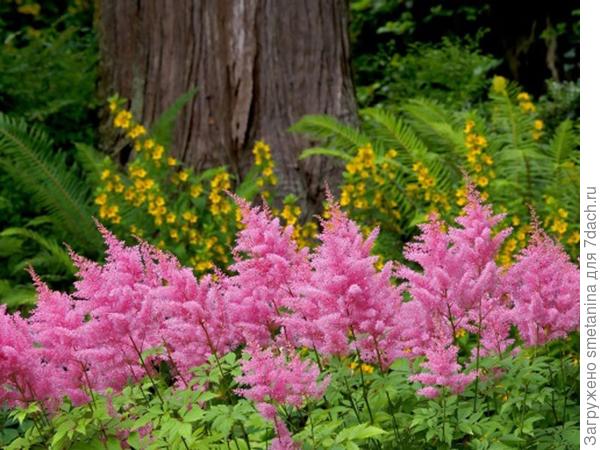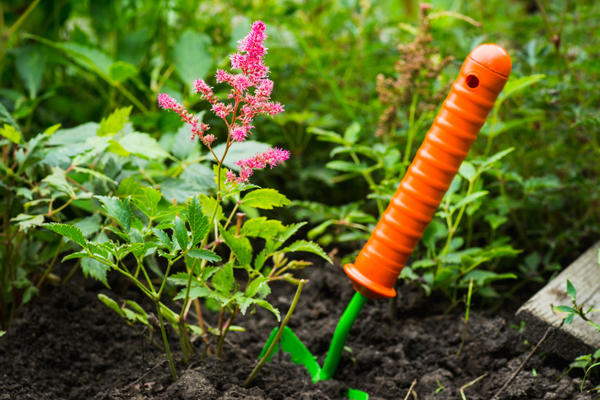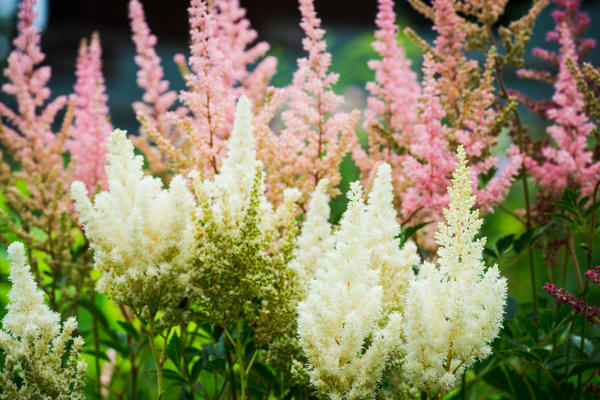Description of the best varieties
A detailed description of varietal forms of astilba allows you to make the right choice - in favor of the most suitable from the point of view of decorativeness and the most unpretentious plant. In culture, about ten plant species have found widespread use, on the basis of which, thanks to selection, many hybrid forms and varieties have been obtained.

Hybrid Astilbe Arends or Astilbe arendsii has become popular due to its ability to grow and develop well in partial shade and high winter hardiness. In addition, this decorative culture is practically not affected by diseases and pests.
| Name | Latin name | Plant height | Leaves | Bloom |
| "Amethyst" | Astilbe arendsii "Amethyst" | 100 cm | Green | Lush, lilac flowers |
| "Boomalda" | Astilbe arendsii "Bumalda" | 40-60 cm | With a reddish tint | Inflorescences are white with a slight raspberry tinge |
| "Spartan" | Astilbe arendsii "Spartan" | 80 cm | Dark green, with shine | The flowers are small, fragrant, bright red, collected in a dense, conical type, paniculate inflorescence |
| Etna | Astilbe arendsii "Etna" | 60 cm | Dark green, with shine | The inflorescence is large, delicate, paniculate, deep red |
| "Ellie" | Astilbe japonica "Ellie" | 50-60 cm | Dark green, tough, deep cut | Large, openwork, paniculate white inflorescence |
Astilba chinensis, from the Latin Astilbe chinensis, is a perennial herb. It has become widespread in home gardening and landscape design due to its unpretentiousness and high decorativeness at the flowering stage.

| Name | Latin name | Plant height | Leaves | Bloom |
| "Visions in red" | Astilbe chinensis "Visions in Red" | 0.4-0.5 m | Green | Fluffy inflorescences of dark crimson color |
| "Pumila" | Astilbe chinensis "Pumila" | 30 cm | Dark green | Lilac-pink flowers |
| Milk & Honey | Astilbe chinensis "Milk and Honey" | 70-80 cm | Light green, darkens over time | Creamy white with a pinkish tinge, powerful inflorescences |
| Hurt & Soul | Astilbe chinensis "Heart and Soul" | 50-60 cm | Double-pinnate, green with a reddish tint | Large, fluffy, pale pink with a purple tinge of inflorescences |
| "Superba" | Astilbe chinensis "Superba" | 100 cm | Green | Lilac-pink inflorescences, collected in openwork panicles |
Japanese Astilba or Astilbe japonica differs from other types of ornamental culture in small densely growing leaves with a pronounced ornament. The average height of an adult plant does not exceed 80 cm. After drying, the inflorescences practically do not lose their shape and continue to decorate the flower garden until mid-autumn.

| Name | Latin name | Plant height | Leaves | Bloom |
| Montgomery | Astilbe japonica "Montgomery" | 50-60 cm | Bright green | Inflorescences of red color |
| "Bremen" | Astilbe japonica "Bremen" | 40-50 cm | Emerald hue | Small crimson flowers are collected in wide fluffy panicles |
| Vesuvius | Astilbe japonica "Vesuvius" | 60 cm | Complex, delicate, glossy, with burgundy petioles | Small, fragrant, collected in a paniculate inflorescence of fiery red color |
| Bonn | Astilbe japonica "Bonn" | 70 cm | Dark green and shiny | Large, openwork, paniculate inflorescence of dark carmine or pink color |
| "Koln" | Astilbe japonica "Köln" | 50-80 cm | Brownish green coloration | Dense fluffy carmine pink inflorescences |
| Deutschland | Astilbe japonica "Deutschland" | 50 cm | Dark green, glossy, on reddish petioles | Small-flowered inflorescence of light pink color |
Take care of clematis roots
The most dangerous thing for a vine is overheating and drying out of the roots, as well as strong drafts. To protect the plants, plant flower beds near the clematis to create the desired shade. As neighbors, lavender, hosts, subulate phlox, peonies, stonecrops, delphiniums are perfect. Nearby, annual plants with a shallow root system will also look beautiful: marigolds, calendula, petunias, salvia, etc.
Such flower beds will require additional watering and feeding, so consider this when choosing plants.
We figured out how to care for clematis, but there are a few more questions that may arise during summer flower care.
Astilba reproduction
Method 1: vegetative.
In the spring, as soon as the plant is dug up and divided into parts, it needs to be planted or the roots are covered with earth.
The astilba bush must be divided into parts. It is recommended to do this so that each has at least one kidney. Better if there are three or more. On each division, it is supposed to leave roots, the length of which is at least three centimeters.
If you plant roots without buds, then astilba will take root, but will not bloom next year. But it will grow and delight with buds in a year.
Method 2: seed.
It is used in the development of new varieties. Astilba seeds are negligible. They can only be seen with a magnifying glass. In September, you need to cut the boxes and put them on paper. After a month, shake out the seeds and collect them in a bag.
Astilba should be planted in February-March. Seeds are supposed to be simply poured onto the surface of wet soil. Cover the container with glass or plastic. Moisten the soil regularly with a spray bottle. Make a pick when the first true leaves appear. After gradual hardening, plant the plants in open ground in early June.



